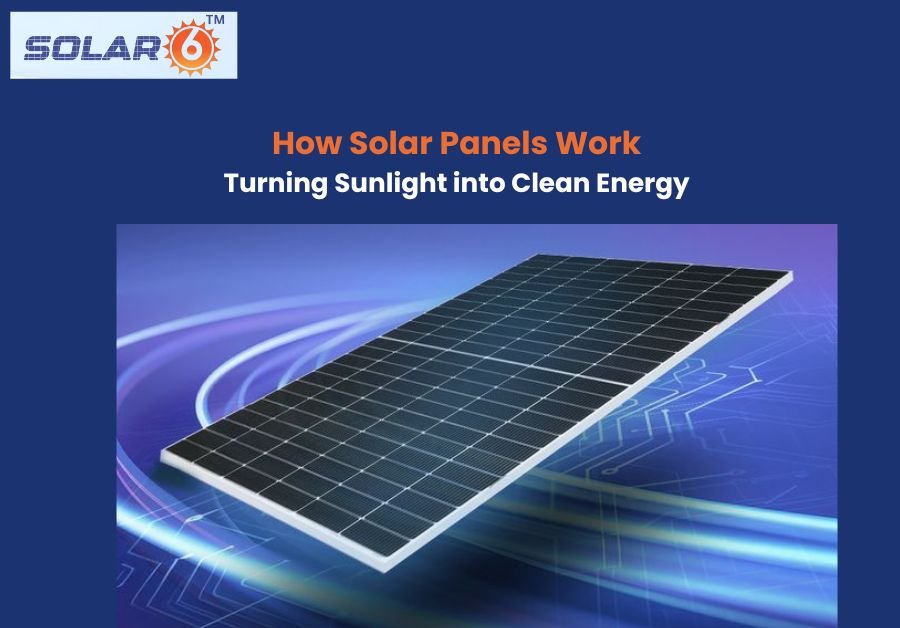In a world dealing with growing electricity demands and environmental challenges, the need for sustainable solutions has never been greater. Among the numerous renewable electricity technologies available today, solar panels are the most popular and powerful way to generate clean, green power.
Every second, the sun releases enormous amounts of energy, and with modern solar technology, we can capture a fraction of this power to light up homes, run businesses, and even charge electric vehicles.
But how exactly do solar panels work? How does sunlight turn into electricity that can power an entire household or office building? In this article, Solar6 explores the fascinating science behind solar energy, the components of a solar power system, its benefits, challenges, and future potential.
1. What Are Solar Panels?
At their core, solar panels—also known as photovoltaic (PV) panels—are devices that convert sunlight into electricity. They are made up of multiple solar cells, most commonly manufactured from silicon, a semiconductor material. When photons from the sun strike these solar cells, they knock electrons loose, generating an electric current.
This process, known as the photovoltaic effect, allows solar panels to generate direct current (DC) power. To make this usable for households and businesses, the DC is converted into alternating current (AC) through an inverter.
2. The Science Behind Solar Energy Conversion
Understanding the photovoltaic effect is key to learning how solar panels generate electricity. Here’s a simple breakdown:
- Sunlight Absorption – Solar panels absorb photons (light particles) from sunlight.
- Electron Excitement – The energy knocks electrons out of their atomic orbits.
- Electric Flow Creation – The movement of electrons generates an electric current.
- DC to AC Conversion – Inverters convert DC electricity into AC, which is used in homes, offices, and industries.
This entire process happens instantly and silently, making solar power systems one of the most efficient and environmentally friendly sources of renewable energy.
3. Main Components of a Solar Power System
A solar installation is more than just panels on a roof. Several components work together to generate and supply electricity:
- Solar Panels (PV Modules): Capture sunlight and convert it to DC electricity.
- Inverter: Converts DC into AC electricity.
- Mounting Structures: Secure the panels on rooftops or the ground.
- Solar Batteries (in hybrid/off-grid systems): Store excess power for night use or outages.
- Net Metering System: Allows users in on-grid systems to sell excess electricity back to the utility company.
Each of these components plays a vital role in ensuring the efficiency and reliability of a solar power system.
4. Types of Solar Panels
Not all solar panels are built the same. The three most common types are:
- Monocrystalline Solar Panels – High efficiency, long lifespan, ideal for small spaces.
- Polycrystalline Solar Panels – Cost-effective, slightly less efficient, popular for residential solar.
- Thin-Film Solar Panels – Lightweight, flexible, often used in large-scale solar farms.
Choosing the right panel depends on your budget, space availability, and energy requirements.
5. Types of Solar Power Systems
Solar panels can be set up in different configurations depending on energy needs:
- On-Grid Solar Systems – Connected to the utility grid, offering benefits like net metering.
- Off-Grid Solar Systems – Independent systems with batteries for storage, perfect for remote areas.
- Hybrid Solar Systems – A mix of both, providing grid connection along with battery backup.
Among these, on-grid solar systems are most widely adopted in urban areas because of their affordability and return on investment.
6. How Efficient Are Solar Panels?
The efficiency of solar panels determines how much sunlight is converted into usable electricity. Most modern panels achieve between 15% to 22% efficiency. While this may sound low, advances in solar technology are continuously improving efficiency levels.
Factors affecting efficiency include:
- Panel quality and material
- Tilt angle and direction
- Location and sunlight availability
- Dust, shading, and temperature
Proper solar panel maintenance ensures maximum efficiency and longevity, typically 25–30 years.
7. Benefits of Solar Energy
Installing solar panels provides a wide range of benefits:
- Environmental Benefits
- Reduces carbon footprint
- Decreases dependence on fossil fuels
- Saves water compared to traditional power plants
- Financial Benefits
- Significant reduction in electricity bills
- Government subsidies and tax incentives
- Increases property value
- Energy Independence
- Reliable power source
- Backup options with solar batteries
- Contribution to a sustainable future
8. Challenges of Solar Panels
Like any technology, solar power systems face certain challenges:
- High upfront installation cost (though prices are falling rapidly)
- Weather dependency, especially in cloudy or rainy areas
- Space requirements for large installations
- Energy storage costs for off-grid setups
Despite these challenges, solar energy adoption is rising due to government subsidies, technological improvements, and falling panel costs.
9. Future of Solar Energy
The future of solar energy looks brighter than ever, with exciting innovations such as:
- Bifacial solar panels that absorb sunlight on both sides
- Solar roof tiles that blend seamlessly with building design
- Perovskite solar cells promise higher efficiency at lower costs.
- Smart solar inverters for better monitoring and control
With continuous research and increasing demand, solar technology trends point toward a world where renewable energy dominates.
10. Real-Life Applications of Solar Panels
Today, solar panels are powering much more than homes:
- Residential Solar Installations: Cutting household electricity bills.
- Commercial Solar Systems: Helping businesses reduce energy costs and boost sustainability.
- Industrial Solar Power: Supporting factories and warehouses with reliable electricity.
- Solar for EV Charging: Powering electric vehicles with renewable energy.
- Rural Electrification: Providing off-grid solar solutions to villages without electricity.
Conclusion: Clean Energy for a Sustainable Tomorrow
Solar panels work is a captivating combo of technology, era, and sustainability. From taking pictures in daylight to generating strength, the technique is both efficient and eco-friendly. As technology improves and costs continue to fall, solar energy is set to come to be the backbone of worldwide energy technology.
By investing in solar, we are not just saving money but also protecting the environment and paving the way for a cleaner, greener planet. The sun provides free energy every day solar panels give us the power to use it wisely. Solar6 provides the best solar panels and helps your financial growth to down your electricity bills.

